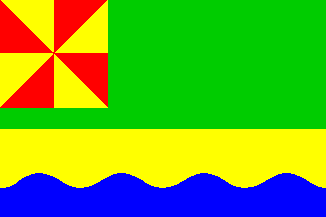
Last modified: 2005-04-16 by jarig bakker
Keywords: oudega |
Links: FOTW homepage |
search |
disclaimer and copyright |
write us |
mirrors
 Shipmate Flagchart : http://www.shipmate.nl/flags.htm
Shipmate Flagchart : http://www.shipmate.nl/flags.htm
Flag: three stripe green, yellow, blue, proportioned 3:1:1; the yellow and blue stripe are connected by a wave; in the canton a square of 1/2 flagheight; the square gironny of yellow and red.
Arms: per fess: a: vert a canton gironny of or and gules; the canton with a cow's head caboshed argent; or an enhanced wavy base azure, charged with five fishes statant argent, the second and fourth are lower than the others.
Flag and arms have been designed at the request of the society for village
interests. The designs are based on ideas from society members. At
the same time it has been tried to connect them with flags and arms of
the neighbouring villages of Heech and De
Gaastmar.
The arms represent cattlebreeding, fishing and the ecological
situation.: water (blue), and meadows (green). The golden stripe
represents the dikes, such as the Skatting, but it can also be seen
as the reeds growing here in the water. The fishes have been arranged in
a unique way ("se geane it wetter út" - they are getting
out of the water) - at the same time they are in the same position as the
fleurs-de-lis on the municipal arms.
In the canton Doris' "mûntsje" (little mill) is represented,
a "spinnekop" (spider-mill) recently restored to its former glory.
8
fields for the octogonal substrate of the mill. The colors are derived
from the old division of Sudergoa (see the arms of Staveren and Nijefurd).
The colors can also be seen as a symbol of the reconstruction (gold)
and the materials used (wood) represented by the heraldic color red.
Furthermore they are used for esthetic reasons.
The flag is a simplification of the arms, and speaks for itself. It
is connected to the villages mentioned above.
Oudega is also an important startingpoint for yachting (Oudegaster Brekken),
but watch out for the man who puts the rudder at 90 degree of the tiller:
there's an awful lot of reed!
Source: Genealogysk Jierboekje 1999, article by R.J. Broersma.
Jarig Bakker, 11 Apr 2005
![[Oudega CoA]](../images/n/nl-fr)og.gif) by Jarig Bakker, 11 Apr 2005
by Jarig Bakker, 11 Apr 2005